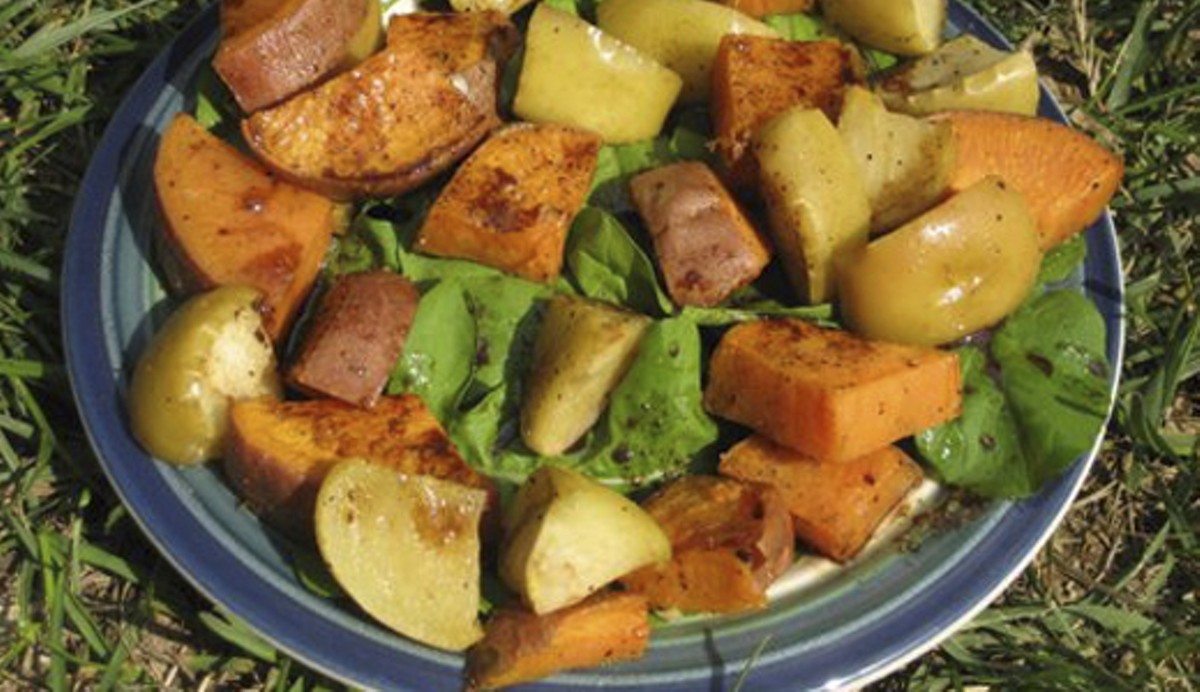Arugula. Is there any other vegetable whose name rolls so luxuriously and seductively off the tongue? For me, the name perfectly captures the depth and complexity of this delicious yet surprisingly underappreciated salad green — invoking its nutty, spicy, buttery flavor as well as the aesthetic of autumn, with the crisp cool air and changing colors. This seasonal treasure is starting to appear at farmers markets around town, and one of the biggest perks of eating locally is the opportunity to sample new varieties of produce.
Added to the joy of exploring new flavors is getting to know the folks who grow your food. My love affair with this green began with the harmonious convergence of both of these pleasures. I clearly remember strolling through the Bardstown Road farmers market last November and being immediately drawn to a stunning pyramid of leafy goodness spilling over the edges of Valerie and Pavel’s Fox Hollow spread. While I’d had vague associations with both Valerie and arugula before that moment, it wasn’t until then that I’d really engaged with either, and since that day, life has just gotten better. I fell so hard for this complex green that I named my favorite house plant arugula, and I’ve not only sown it multiple times, I’ve also explored using it in teas, tonics and other homeopathic and culinary ventures.
One of the most intriguing aspects of arugula is the depth of its flavor, which seems to build with each chew. Although it looks similar to other salad greens, its flavor is entirely distinct. More herblike than salad, it has a nutty, spicy flavor that seems to evolve and deepen the longer it lingers on your taste buds. Chew slowly, savor fully and allow these dandelion-like leaves to dazzle your palette with their tender complexity.
In terms of eating seasonally, I think arugula is an excellent bridge from warm September days to cooler autumn temperatures. It offers a gentle transition to cooler days, and the way it coaxes us to slow down and savor its flavor escalation is a subtle reminder to savor our own inward turning and reflection during the coming months.
So what is arugula? An herbaceous annual plant native to Europe and western Asia, it’s also known as rocket and is related to watercress, mustard and radishes. Often used as a salad herb, a handful of the leaves can be added to lettuce or other green mixes, as a little goes a long way. In terms of nutritional benefits, arugula is also a good source of thiamin, riboflavin, vitamin B6, pantothenic acid, zinc and copper, and provides all the typical goodness of any fresh, leafy green. Grown in the Mediterranean region since Roman times, arugula was often used as an ingredient in aphrodisiac potions dating back to the first century.
So now you’re ready to take the leap and try something new from your local growers. How about pairing it with something familiar to ease the transition?
Farmers markets across the region are brimming with two fall favorites — apples and sweet potatoes, whose widespread popularity has made them mainstays in many seasonal recipes. Not only are they easy to find locally this time of year, they’re both full of health benefits and store quite well.
The Center for Science in the Public Interest ranked the sweet potato number one in nutrition of all vegetables, based on its content of dietary fiber, naturally occurring sugars and complex carbohydrates, protein, vitamins A and C, iron and calcium. It has almost twice the recommended daily allowance of vitamin A, 42 percent of the recommendation for vitamin C, four times the RDA for beta carotene and, when eaten with the skin, the sweet potato has more fiber than oatmeal. Additionally, among root vegetables, sweet potatoes offer the lowest glycemic index rating. That’s because the sweet potato digests slowly, causing a gradual rise in blood sugar so you feel satisfied longer.
We all know apples are healthy. As a source of both soluble and insoluble fiber, the pectin fiber in apples actually helps prevent cholesterol buildup in the lining of blood vessel walls, thus reducing the incidence of atherosclerosis and heart disease. The insoluble fiber provides bulk in the intestinal tract, holding water to cleanse and move food quickly through the digestive system.
But there’s more to apples than the known nutritional highlights; in the world of plant-spirit medicine, they offer a wellspring of healing attributes. Not only do they have remarkable cleansing properties, clarifying the complexion, refreshing and toning the gums; they also remove toxins from the digestive system, and apple tea is known for benefiting the urinary tract. As a flower essence, apple blossoms detoxify the mind and body to restore emotional well-being and are reputed to draw in spiritual energies to encourage a healthy outlook on life. Finally, apples have carried a sacred significance since ancient times, symbolizing love, happiness and fertility, and several myths link apples to opening the heart to new love. What more could you ask for in a fruit?
Paired with sweet potatoes, apples provide the perfect sweet accent to the piquant and nutty arugula. Combine it with a tangy vinaigrette and wait for your taste buds to swoon.
Arugula and Roasted
Fall Vegetables
1 large bunch of arugula
2 medium-sized sweet potatoes
2 tart apples
1 tablespoons of olive oil
Salt and pepper to taste
Preheat oven to 450 F. Wash and chop potatoes and apples into bite-sized pieces; toss with oil, salt and pepper and bake on an oiled baking sheet for 20 minutes. Allow to cool and then serve over a bed of arugula with vinaigrette.
Vinaigrette
1 tablespoon of mustard
2 tablespoons of olive oil
2 tablespoons of balsamic vinaigrette
1 teaspoon of maple syrup
Salt and pepper to taste






